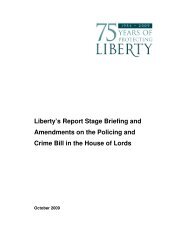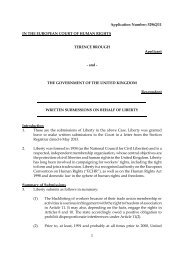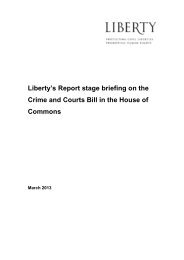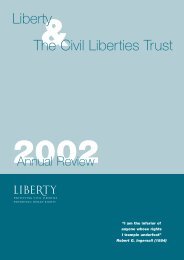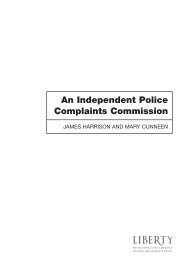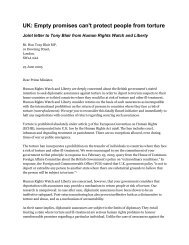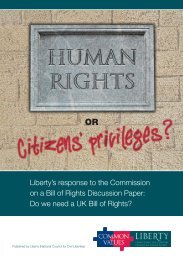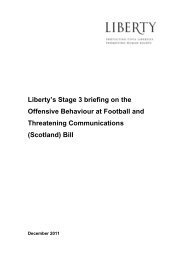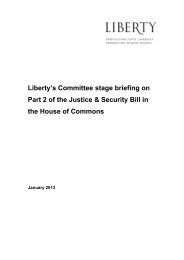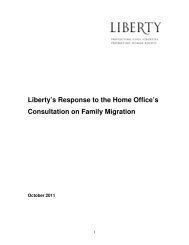Overlooked - Liberty
Overlooked - Liberty
Overlooked - Liberty
You also want an ePaper? Increase the reach of your titles
YUMPU automatically turns print PDFs into web optimized ePapers that Google loves.
16 <strong>Overlooked</strong>: Surveillance and personal privacy in modern Britain<br />
So how much have things changed in recent years Upon waking up today it is unlikely any of us<br />
felt more subject to surveillance than we did yesterday. This makes the societal shift difficult for<br />
individuals to comprehend. Added to this is the fact that, by its very nature, much surveillance takes<br />
place without our being aware of it. Even that most obvious symbol of surveillance, the ubiquitous<br />
CCTV camera, is so often seen as to fade into the background. It is unlikely that many people<br />
register the fact that each camera will be recording their movements for the time they are in range.<br />
If we were to jump 10 years into the future however, we would most likely be able to identify some<br />
dramatic changes. We might even be surprised by the extent of public indifference to them.<br />
In November 2006 the Office of the Information Commissioner produced its ‘A Report on the<br />
Surveillance Society’ 24 . This provided a detailed and comprehensive analysis of the nature and<br />
extent of surveillance in 2006. Part of the report contrasts a week in the life of a family living in 2006<br />
and 2016. The projection into the year 2016 imagined a society of Identity Cards, private security,<br />
mobility tracking and remote controlled spy planes. All the predictions are either the culmination of<br />
current plans or new generations and developments of existing technology. While far from the realm<br />
of science fiction, the world of 2016 imagines days spent in constant surveillance to a degree that<br />
makes uncomfortable reading for anyone concerned with values of privacy.<br />
In order to gauge the nature and extent of surveillance in the present it is necessary to categorise<br />
two broad types. Reference has already been made to ‘mass surveillance’. This can be broken<br />
down into mass informational surveillance (essentially databases) and mass visual surveillance (such<br />
as CCTV). These are not targeted at any particular individual but store information in anticipation of<br />
possible use at some future point. Of course this does not have to relate to crime or national security<br />
purposes. The justification for information collection and dissemination powers created by the<br />
Children Act 2004 to be contained on the ‘children’s index’ was child protection. The proposed NHS<br />
central data spine of patient’s records is intended to allow easier nationwide access to information<br />
for health service providers. This might be obvious but demonstrates the simple-mindedness of the<br />
often cited comment, ‘nothing to hide, nothing to fear’. Conflation of privacy and criminality<br />
presumes that those who are not criminals do not need to place a value on their privacy. This is<br />
clearly nonsensical as it is difficult to imagine any situation where a person would be comfortable<br />
with unfettered access to his or her medical records or the information about their children that will<br />
be contained on the children’s index.<br />
The other main type of surveillance is targeted surveillance by agents authorised by the state. The<br />
legal framework permitting targeted surveillance is set up under the Regulation of Investigatory<br />
Powers Act 2000 (RIPA). RIPA identifies different forms of surveillance such as communication<br />
interception, the use of undercover operatives and the capture of communication traffic data. The<br />
Act creates differing authorisation procedures according to the type of surveillance, while secondary<br />
legislation lists those public bodies that can use each power.<br />
The focus of targeted powers under RIPA is criminality. Many of the agencies who are authorised to<br />
use targeted surveillance powers are not ‘policing’ bodies. Local Authorities, food and fishing<br />
agencies, the Charity Commission and many other bodies have RIPA authorisations (although many<br />
of these only have less intrusive powers such as access to communications data). However, in<br />
24<br />
http://www.ico.gov.uk/upload/documents/library/data_protection/practical_application/surveillance_<br />
society_full_report_2006.pdf



